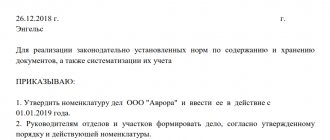The organization regularly receives various documents - from suppliers, clients, employees, correspondence is received, internal orders and orders are issued. Personnel does not lag behind and documents on employees are added here - calculations of sick leave, vacations, wages, etc. If you store all this mass indefinitely, you will have to rent a very large office.
To avoid being buried under an avalanche of boxes and folders, you need to be guided by the List of documents and their storage periods (approved by Order No. 236 dated December 20, 2019, valid from February 18, 2020, hereinafter referred to as the List). It contains more than 200 pages, which, of course, are difficult to re-read, so we will talk about the main documents that are found in every organization, the rules and their retention periods.
Archival storage of documents and files is the responsibility of every organization
The obligation to store documents in the organization’s archives and storage periods are provided for by various laws.
Thus, the storage period for tax purposes is determined by the Tax Code. For accounting documents, the deadline is fixed by the Law “On Accounting” dated December 6, 2011 No. 402-FZ. How long to store documents on personnel is indicated by the Law “On Archival Affairs” dated October 22, 2004 No. 125-FZ. A set of storage periods can also be found in the order of the Federal Archive of Russia dated December 20, 2019 No. 236.
Attention! Order of the Ministry of Culture No. 558 dated August 25, 2010, which regulated storage periods until 2021, became invalid as of February 18, 2020. See here for details.
Read about the nuances of applying Order No. 236 in the article “List of document storage periods approved by Rosarkhiv” .
To make it easier for you to understand the storage periods for documents in the archive, we have compiled a consolidated table of the main documentation that arises in the course of work of any organization.
Where to store large volumes of documents
Delis Archive offers services for storage, archival processing and destruction of documents. In addition, we can:
- Prepare and submit documents to the state archive;
- Prepare documents at the request of tax, judicial and other government authorities;
- Store personnel documents and issue social certificates to employees;
- Scan accounting documents and create an electronic archive;
- Conduct personnel selection for archivists, record keepers, and scanning specialists.
Would you like to learn more about our archive or leave a request? Enter your contacts in the form below, we will contact you and help you arrange document storage:
Storage periods for documents in the organization’s archive: table
| Document type | Shelf life, years (minimum) |
| Personnel | |
| Personnel documents: | |
| 75 |
| 50 |
These deadlines apply in particular to:
| |
| Other HR documents (time sheets, lists, travel documents). | 10 |
| For more information about this, see the article “What is the storage period for personnel documents in an organization?” . | |
| Occupational Health and Safety (OH&S) | |
| Lists and time sheets of workers in special working conditions (harmful, dangerous, difficult) | 75 |
| Acts on occupational diseases, investigation materials | 75 |
| Documentation of accidents (acts, registration logs, investigation materials) | 45 |
| Logs of preventive work and training on TB | 10 |
| Statements for issuing special clothing and special food | 1 |
| See the article “What are the storage periods for occupational safety documents?” . | |
| Accounting and taxes | |
| Annual accounting | 5 years |
| Reporting to the Social Insurance Fund: | |
| 50/75 |
| 50/75 |
| Reporting to the Pension Fund: | |
| 50/75 |
| 75 |
| Information about the income of individuals | 5 |
| Tax returns and registers | 5 |
| Accounting policies, including appendices thereto | 5 |
| Primary accounting and registers | 5 |
| Cash documents | 5 |
| For more details, see the material “What is the shelf life of cash documents?” . | |
| Invoices | 5 |
| For them, read the publication “What is the shelf life of invoices?” . | |
In the table we have given only the most basic shelf life. If you have access to ConsultantPlus, you can always find in it the storage period for any document you need. If you don’t have access, you can get trial access for free and look at the storage period directory, as well as find any information that interests you.
The best way to store cooked pasta
Once you've cooked the pasta, let the leftovers cool and then place them in the refrigerator within 2 hours of cooking.
If pasta is placed in the refrigerator while warm, the resulting increased humidity in the pan can create an ideal environment for the growth of bacteria or mold (,).
Refrigerated pasta should be stored in shallow, airtight containers.
To prevent the pasta from sticking too much in the refrigerator, add butter to it after cooking.
Finally, be sure to store food in the refrigerator at 4°C or below ().
How to Safely Reheat Leftover Pasta
When you're ready to eat your leftover pasta, you can eat it cold or reheat it using a few recommended methods.
If you're eating plain pasta without sauce, you can reheat it by placing it in a strainer and submerging it in boiling water for about 30 to 60 seconds.
The remaining pasta and sauce can be placed in a heatproof bowl and reheated in the oven for about 20 minutes at 170°C.
They can also be placed in a skillet on the stove and heated over medium heat, stirring occasionally, until heated through.
A covered, microwave-safe plate can also work well for reheating leftover pasta.
If your pasta is properly cooled to 4°C and you want to eat it cold, there is a small risk of bacterial contamination, but only if it is stored for no more than 3-5 days.
When reheating, be sure to reheat them to at least 74°C and eat within 2 hours to prevent bacterial growth ().
Conclusion:
To optimize shelf life, cooked pasta should be refrigerated at 4°C or colder in an airtight container. Leftovers can be enjoyed cold or warmed using boiling water, stove top, microwave or oven.
Nuances of calculating shelf life
The first thing you should pay attention to when “bookmarking” a document in the archive is the moment from which the storage period begins to be calculated. Thus, for some personnel documents it starts immediately from the date of preparation, and for primary accounting documents - at the end of the reporting year.
For tax purposes, the storage period begins after the reporting period in which the document was last used to calculate taxes and participated in the generation of reporting.
About the storage periods for documents on depreciable property, read the material “From when should the storage period for primary assets be calculated?” .
The second important nuance is that the retention period established for one document by different legal acts may vary. If this is the case, you need to choose the maximum one.
Let us explain both nuances with an example.
An example of determining the storage period for a work acceptance certificate
Let’s say the act was drawn up on March 29, 2017. Let's determine its shelf life:
- As a primary accounting document confirming the accounting of expenses, it must be stored for 5 years from the end of the reporting year 2021, i.e. from 01/01/2018 to 12/31/2022.
- As a document confirming the fact of acceptance of the results of work for VAT purposes - 4 years from the end of the first quarter of 2021 (VAT tax period), i.e. from 04/01/2017 to 03/31/2021.
- As documentary evidence of income tax expenses - 4 years from the end of the “profitable” tax period of 2021, i.e. from 01/01/2018 to 12/31/2021.
We choose the latest date - 12/31/2022. After this, the document can be destroyed.
For information on how to do this in accordance with all the rules, read the article “Destruction of documents with expired storage periods (act)” .
Helpful tips for storing prepared food in the refrigerator
- An airtight container is a must for storing any prepared food, as oxygen stimulates the growth of bacteria. And to avoid condensation, simply place a sheet of paper towel under the lid and change it from time to time.
- Regularly monitor the temperature in the refrigerator: it should not exceed 4 °C.
- The temperature at the back of the refrigerator is lower than near the door, so think carefully about the placement of containers.
- Be sure to make notes on the container with the time and date of placement, especially if there are people in the family who like to snack individually.
- Do not put containers with hot or warm leftover food in the refrigerator, this increases the rate of spread of bacteria and harms the operation of the refrigerator.
- A small amount of lemon juice added to the dish will prolong its shelf life.
- If you want to preserve the product for a long time, use the freezer. Do this with broths , pouring them into ice cube trays or filling zip bags halfway with liquid.
- If a dish is stored longer than expected, do not freeze it, but throw it away without regret. Take care of yourself and your loved ones!
Store any prepared food in food containers
Results
When organizing an archive in a company, you should remember that the storage periods for one document serving in different capacities can be established by different legal acts and therefore vary. In this case, the period should be calculated to the maximum. Until its expiration, the document must be kept in the company's archives and cannot be destroyed.
Sources:
- Law “On Accounting” dated December 6, 2011 No. 402-FZ
- Order of Rosarkhiv dated December 20, 2019 No. 236
- Order of the Ministry of Culture of Russia dated August 25, 2010 No. 558
You can find more complete information on the topic in ConsultantPlus. Free trial access to the system for 2 days.
Wine
Wine can live in a bottle for many years. How much depends on the type of wine. In the bottle it even changes its taste properties as it ages. It becomes more rich and interesting. But in the same bottle it can “break”. Simply lose all these taste properties and become flat sour. Each wine has its own time. But usually wine can last at least 2 years in a bottle.
Does champagne have a shelf life? More details
Archive functions
Each archive has certain functions. So, let's list them.
- Creation of lists by an archive employee. The list indicates which structural unit the organization belongs to.
- Acceptance of documents from any organizations.
- Continuous reporting on the safety of the data that is stored.
- Timely notification of persons who transferred documents for preservation about the safety of data.
- Maintaining records that show for what purposes a particular document was used.
- Constant control over filling out documents.
- Continuous professional development of archival staff.
Signs of a bad omelet
You can determine that a product is no longer suitable for consumption by the following signs:
- The appearance of mold spots on the surface. They can be white, black, green or multi-colored.
- Drying of eggs.
- Formation of unpleasant mucus on the surface.
- Color change. As a rule, a rotten omelette turns dark.
- Unpleasant musty or sour odor.
A missing omelette cannot be eaten . The product develops pathogenic microorganisms and fungi, the entry of which into the gastrointestinal tract can cause severe poisoning. You should be especially wary of dishes with darkening and stains on the surface. This may be mold that can affect various organs of the human body, primarily the liver.
Company archive and third-party archive
Documents that have a permanent storage period and temporary ones, but more than 10 years, are transferred to the company archive. Completed cases are transferred according to their inventory. When sending cases to a third-party archive (most often a state or municipal institution), they are accompanied by the following:
- a letter of relationship with a request addressed to his supervisor, which indicates the number of cases and their last dates;
- inventory in 3 copies;
- historical information about the company (only for the first application);
- a certificate documenting the incomplete preservation of files or individual documents in them, if necessary.
Cases are handed over according to the act according to the inventories. After passing the examination, the cases are accepted by the archive for storage.
When is the archive organized?
It is prohibited to set up archives in buildings that do not comply with fire safety. These are wooden buildings. The room must have an appropriate atmosphere: there should be no moisture or stove heating. All this can cause data corruption.
Most often, archival buildings stand separately from other premises. It is forbidden to establish public catering places near the archive. In addition, objects and devices that could cause a fire should not be placed nearby.
When choosing premises for archives, you need to keep in mind that all storage facilities are divided into:
- archives of temporary data storage;
- archives with documents that are used very often;
- archives for long-term storage of documents;
- premises where archivists work.







